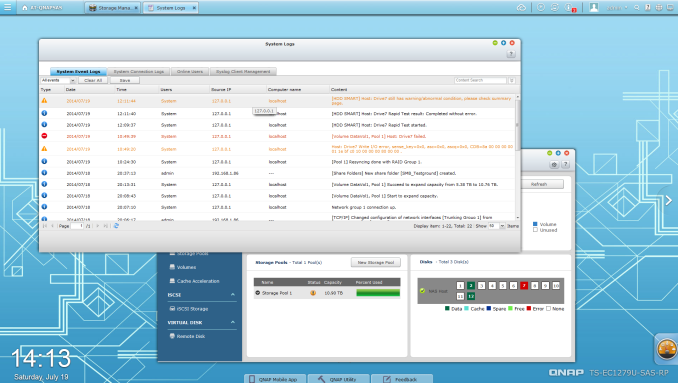6 TB NAS Drives: WD Red, Seagate Enterprise Capacity and HGST Ultrastar He6 Face-Off
by Ganesh T S on July 21, 2014 11:00 AM ESTMiscellaneous Aspects and Final Words
In the process of reviewing the Western Digital Red 6 TB drives, we did face one hiccup. Our QNAP testbed NAS finished resyncing a RAID-5 volume with three of those drives, but suddenly indicated an I/O error for one of them.
We were a bit surprised (in all our experience with hard drive review units, we had never had one fail that quickly). To check into the issue, we ran the SMART diagnostics and also a short test from within the NAS UI. Even though both of them passed clean, the NAS still refused to accept the disk for inclusion in the RAID volume. Fortunately, we had a spare drive that we could use to rebuild the volume. Putting the 'failed' drive in a PC didn't reveal any problems either. We are chalking this down to compatibility issues, though it is strange that the rebuilt volume with the same disks completed benchmarking without any problems. In any case, I would advise prospective consumers to ensure that their NAS is in the compatibility list for the drive before moving forward with the purchase.
RAID Resync and Power Consumption
The other aspect of interest when it comes to hard drives and NAS units is the RAID rebuild / resync times and the associated power consumption numbers. The following table presents the relevant values for the resyncing of a RAID-5 volume involving the respective drives.
| QNAP TS-EC1279U-SAS-RP RAID-5 Volume Resync | ||||
| Disk Model | Duration | Avg. Power | ||
| Western Digital Red 6 TB | 14h 27m 52s | 90.48 W | ||
| Seagate Enterprise Capacity 3.5" HDD v4 6 TB | 10h 24m 22s | 105.42 W | ||
| HGST Ultrastar He6 6 TB | 12h 34m 20s | 95.36 W | ||
Update: We also have some power consumption numbers under different scenarios. In each of these cases, we have three of the drives under consideration configured in a RAID-5 volume in the NAS. The access mode is exercised by running the corresponding IOMeter trace from 25 clients simultaneously.
| QNAP TS-EC1279U-SAS-RP RAID-5 Power Consumption | |||
| Workload | WD Red 6 TB | Seagate Enterprise Capacity 3.5" HDD v4 6 TB | HGST Ultrastar He6 6 TB |
| Idle | 79.34 W | 87.16 W | 84.98 W |
|
Max. Throughput (100% Reads) |
93.90 W | 107.22 W | 97.58 W |
|
Real Life (60% Random, 65% Reads) |
84.04 W | 109.25 W | 94.03 W |
|
Max. Throughput (50% Reads) |
96.74 W | 112.82 W | 99.25 W |
|
Random 8 KB (70% Reads) |
85.22 W | 105.65 W | 91.47 W |
As expected, the Seagate Enterprise Capacity 3.5" HDD v4 consumes the most power, while the He6 is much better off thanks to its HelioSeal technology while retaining the same rotational speed. The WD Red, on the other hand, wins the power efficiency battle as expected - a good thing for home consumers who value that over pure performance.
Concluding Remarks
We have taken a look at three different 6 TB drives, but it is hard to recommend any particular one as the clear cut choice unless the particular application is known. The interesting aspect here is that none of the three drives have overlapping use-cases. For home consumers who are interested in stashing their media collection / smartphone-captured photos and videos and expect only four or five clients to simultaneously access the NAS, the lower power consumption as well as the price of the WD Red 6 TB is hard to ignore. For users looking for absolute performance and those who need multiple iSCSI LUNs for virtual machines and other such applications would find the Seagate Enterprise Capacity v4 6 TB a good choice. The HGST Ultrastar He6 is based on upcoming technological advancements, and hence, carries a premium. However, the TCO aspect turns out to be in its favour, particularly when multiple drives running 24x7 are needed. It offers the best balance of power consumption, price and performance.











83 Comments
View All Comments
riya_somani - Thursday, June 9, 2016 - link
Thanks for explaining in such a detail, This is very useful information. Experienced users opinions also matters a lot. http://www.mouthshut.com/External-HardDisks is best to check user reviews of any hard disk.Georgegxr - Wednesday, September 9, 2020 - link
https://clck.ru/QB2RhРаньше пользователи CryptoTab PRO могли ускорять майнинг исключительно около помощи функции Cloud.Boost. Мы решили пойти дальше и предоставить вам доступ к новейшей опции Super.Boost, воеже вы зарабатывали больше — и быстрее! Оцените преимущества сверхскоростного майнинга с расширением Super.Boost, доступным в PRO-версии Android приложения.
Используйте разом порядочно ускорений Super.Boost и увеличьте общую резвость майнинга на всех ваших устройствах с включеннойй функцией Cloud.Boost. https://clck.ru/QB2Rm
Примерно, скорость вашего устройства — 100H/s, с Cloud.Boost X10 скорость составит уже 1000H/s. А с двумя дополнительными ускорениями Super.Boost +80% и +60% суммарная быстрота майнинга довольно равна 2400H/s (1000H/s + 1000H/s*0,8 + 1000H/s*0.6 = 1000 + 800 + 600).
Скачай CryptoTab PRO и открой для себя сверхбыстрый майнинг! https://clck.ru/QB2Pu
Устанавливая PRO-версию Android-приложения кроме опции Super.Boost, вы также получите расширенный коллекция функций:
Cloud Help — часто ускоренный майнинг
Занятие SDP: сервер-зависимый майнинг не тратит заряд батареи
Бойкий доступ к кабинету для хранения и вывода криптовалюты
Неограниченное цифра подключённых удалённых устройств
Обновление баланса единожды в 10 минут
Неограниченный умозаключение средств от 0.00001 BTC
Отдельные профили ради разных пользователей
Защищенный профиль чтобы публичного Wi-Fi
Приоритетная техническая помощь
Адаптивная новостная лента
Никакой надоедливой рекламы
Специальные промо-материалы и распродажи
Майнинг для мобильных устройствах паки никогда не был таким быстрым! Скачай Android-приложение, включи Cloud.Boost и открой для себя суперскоростной майнинг с функцией Super.Boost.
Перейти по ссылке: https://clck.ru/QB2SU
@Crypto_Good